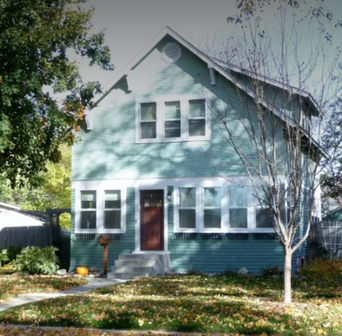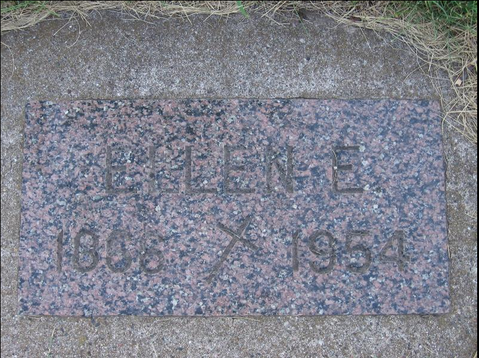Ellen Elizabeth Callaghan
No photos available
Birth: 1868, Rosemount, Dakota, Minnesota
Death: 30 Apr 1954, Farmington, Dakota, Minnesota
Burial: Vermillion Township, Dakota, Minnesota
Never married, no children.

Ellen Elizabeth Callaghan (named after her Grandmother Condon) was born in 1868 in Rosemount Township, Minnesota. Known as Nellie, she was the third child of William Callaghan and Mary Condon. Like her siblings, Nellie, though long-lived, did not leave much of a footprint behind. She lived most of her life on her father’s farm where she served as the housekeeper and primary caregiver for her parents and, later, her siblings. She never married nor had any children.
Life on a Minnesota farm in the 19th Century was tough. The winter days were short and the nights freezing. The Spring and Summer were full of hard work. As the eldest daughter, Nellie would have been her mother’s right hand, helping with the cooking and cleaning, taking care of the chickens and milking the cows, and raising her six younger siblings.
There also school. According to Annette Atkins at https://www.mnopedia.org/learning-land-lakes-minnesota-s-education-history,
Nineteenth-century New England reformer Horace Mann largely invented the American common school: a free, public, non-sectarian, graded institution for boys and girls (together), with trained teachers. Young, ambitious, single, and coming of age in the bubbling cauldron that was Jacksonian America, young women provided the foundation of the new public-school system throughout the North, including Minnesota. Harriet Bishop, the first to arrive in Minnesota, opened her Mannian school in St. Paul in 1847. Nearly 500 other women, recruited through the Board of National Popular Education (run by Catharine Beecher, sister of Harriet Beecher Stowe), helped create Minnesota’s public-school system. Some districts—especially urban ones—hired as many of these trained “outsiders” as possible. Others—especially sparsely populated ones—were happy with young females who could read and write.
William and Mary also believed in education. In 1776, Americans could anticipate three months of formal education in their lifetimes. Nellie would receive eight years in a one room school house over two twelve-week semesters per year.
Nellie’s mother died in 1898, leaving her as the de facto woman of the house. After her father died in 1924, she received a cash sum from the estate that was triple that of her siblings and bought a house at 40 – 3rd Street in the town of Farmington. The house no longer exists. In the 1930 US Census, six years after her father’s death, Nellie was listed as Head of household, and she owned 40 – 3rd Street in Farmington the free and clear. Mary Ann, Kate, and William were living with her.
Sometime after 1935, Nellie, Kate, and Mary Ann moved to Los Angeles to live with Maggie at 2140 ½ Vallejo Street. James had come down from Portland, Oregon, to live with them as well. They were all there in 1940 for the 1940 US Census. Maggie died in 1945, though, and the sisters moved back to Farmington where they bought the three-bedroom, one bath house at 701 - 3rd Street in Farmington. Built in 1916, she and her remaining two sisters would live the rest of their lives there.
Life on a Minnesota farm in the 19th Century was tough. The winter days were short and the nights freezing. The Spring and Summer were full of hard work. As the eldest daughter, Nellie would have been her mother’s right hand, helping with the cooking and cleaning, taking care of the chickens and milking the cows, and raising her six younger siblings.
There also school. According to Annette Atkins at https://www.mnopedia.org/learning-land-lakes-minnesota-s-education-history,
Nineteenth-century New England reformer Horace Mann largely invented the American common school: a free, public, non-sectarian, graded institution for boys and girls (together), with trained teachers. Young, ambitious, single, and coming of age in the bubbling cauldron that was Jacksonian America, young women provided the foundation of the new public-school system throughout the North, including Minnesota. Harriet Bishop, the first to arrive in Minnesota, opened her Mannian school in St. Paul in 1847. Nearly 500 other women, recruited through the Board of National Popular Education (run by Catharine Beecher, sister of Harriet Beecher Stowe), helped create Minnesota’s public-school system. Some districts—especially urban ones—hired as many of these trained “outsiders” as possible. Others—especially sparsely populated ones—were happy with young females who could read and write.
William and Mary also believed in education. In 1776, Americans could anticipate three months of formal education in their lifetimes. Nellie would receive eight years in a one room school house over two twelve-week semesters per year.
Nellie’s mother died in 1898, leaving her as the de facto woman of the house. After her father died in 1924, she received a cash sum from the estate that was triple that of her siblings and bought a house at 40 – 3rd Street in the town of Farmington. The house no longer exists. In the 1930 US Census, six years after her father’s death, Nellie was listed as Head of household, and she owned 40 – 3rd Street in Farmington the free and clear. Mary Ann, Kate, and William were living with her.
Sometime after 1935, Nellie, Kate, and Mary Ann moved to Los Angeles to live with Maggie at 2140 ½ Vallejo Street. James had come down from Portland, Oregon, to live with them as well. They were all there in 1940 for the 1940 US Census. Maggie died in 1945, though, and the sisters moved back to Farmington where they bought the three-bedroom, one bath house at 701 - 3rd Street in Farmington. Built in 1916, she and her remaining two sisters would live the rest of their lives there.
On April 30, 1954, Nellie Callaghan died at the Sanford Hospital. She was 86. After a requiem mass at St Michael’s Church officiated by Fr. Michael Donovan, she was buried with her parents and siblings at St. Agatha’s Cemetery. The Dakota Tribune summed up her life by saying,
Miss Callaghan was highly respected in the community and was a daughter of county pioneers who settled in Empire township. An influence for good where ever she lived or worked and was devoted to her church and her home.
Miss Callaghan was highly respected in the community and was a daughter of county pioneers who settled in Empire township. An influence for good where ever she lived or worked and was devoted to her church and her home.
